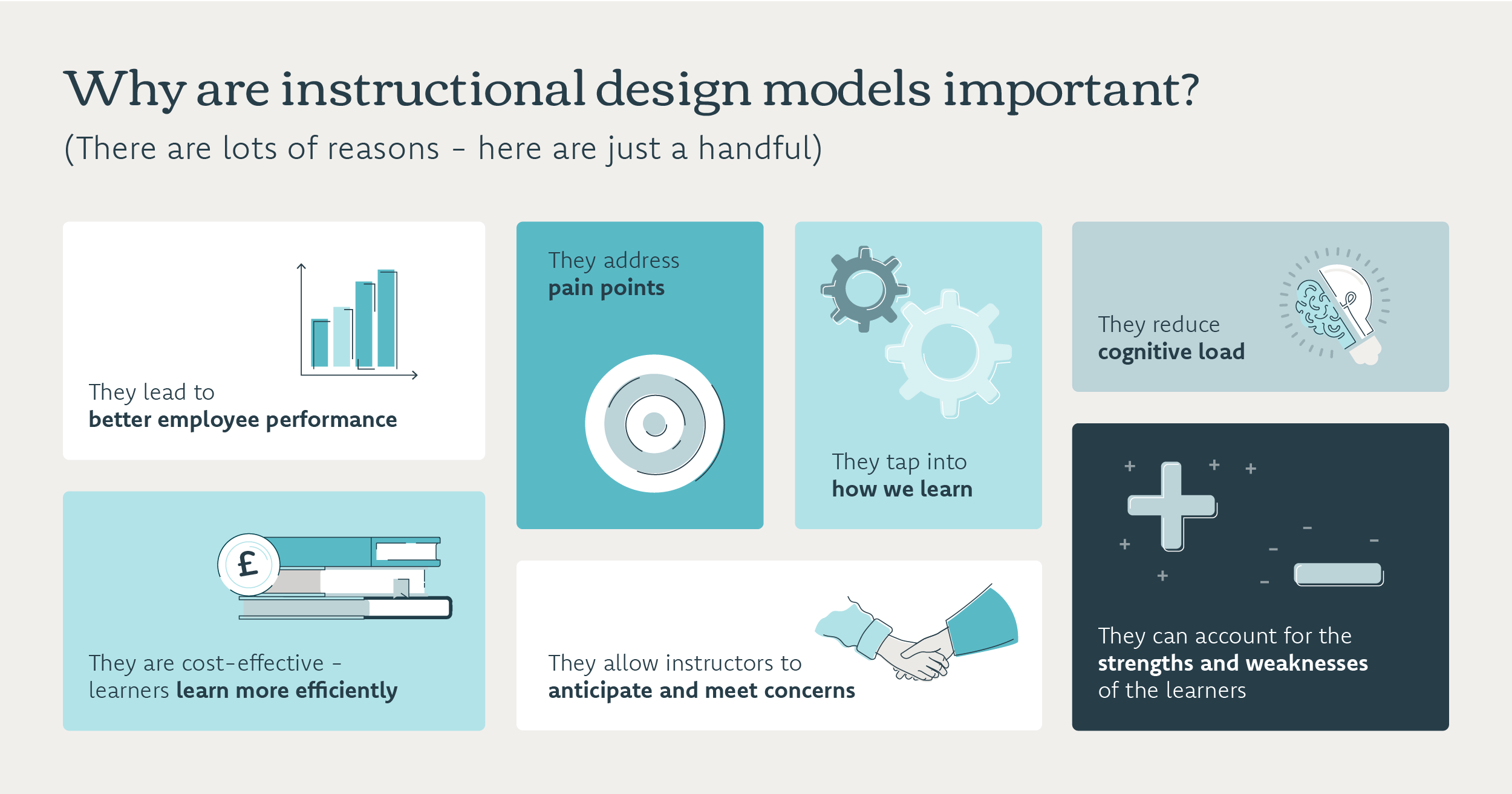L&D is as important as ever.
A recent survey reported that 83% of workers considered training a ‘vital’ factor when it came to choosing an employer. And 66% say they would quit within a year if their L&D needs weren’t met.
Eyebrow-raising stuff.
For the half of organisations that require L&D on an annual basis, and the 53% of workers whose jobs requires specialist training, it’s important that you get your training programme right.
But how?
Step forward instructional design.
Instructional design (ID) is how you design and deliver effective and engaging learning programmes – supported by learning theory.
Principles of instructional design stem from WW2, when war efforts meant that large numbers of people needed to be trained – and quickly. (ID is also rooted in cognitive and behavioural psychology and other disciplines, including engineering.)
The instructional design models (IDMs) that have emerged from this can be tailored to fit any learning programme. And they are vital. In the same way you wouldn’t build a house without plans, you shouldn’t embark on an L&D programme without a blueprint. Luckily, there are plenty of models out there to help.
Let’s take a quick tour of five of the best around.
1. ADDIE
Created for the US military by Florida State University in the mid-1970s, ADDIE is a ‘waterfall’ model and one of the most popular IDMs around. It flows in a cycle, like this:
Analyse – don’t guess at what the audience needs and why: properly analyse issues
Design the instructions and content
Develop learning materials that the audience will engage with
Implement – i.e. deliver – the learning materials
Evaluate – how effective was the learning programme?
PROS:
- ADDIE is a nicely-structured cycle
- It’s logical and straightforward – yet still flexible enough to be tailored to your learning needs
- It’s versatile and can be used for pretty much any type of learning programme
CONS:
- ADDIE can be time consuming
- It perhaps leaves a bit too much to interpretation
- There is perhaps too much separation of the Design phase from the Development and Implementation phases
2. SAM
A simplified version of ADDIE, the Successive Approximation Model was developed by educational psychologist Dr Michael Allen in 2012. It has an iterative and agile approach of: evaluate, design, develop (then repeat). Primarily used in e-learning, it involves plenty of prototyping and constantly asks, “How close are we getting to our goals using this learning programme?”
PROS:
- SAM is quick to incorporate budgetary and resource issues
- Lots of evaluation is built-in
- It allows for rapid feedback to assess its workability
CONS:
- SAM can be a bit repetitive
- There can be disharmony due to many competing voices
- It can be lengthy and costly

3. Dick and Carey
The Dick and Carey model is a systems-oriented approach to instructional design. It’s based on the research of Walter Dick (of Florida State University) and Lou and James Carey (University of South Florida). The emphasis is on identifying instructional goals: i.e. What is being taught? Who is being taught? Why are they being taught?
PROS:
- Dick and Carey is comprehensive, covering all components of instructional design
- It emphasises constant evaluation and revision
- It breaks down well the design and development process
CONS:
- Dick and Carey can become lengthy and complex
- There’s lots of overlap and it may be difficult to distinguish between phases
- There’s little room for manoeuvre and flexibility – stages must be completed before progressing
4. Bloom’s Taxonomy
First created by Benjamin Bloom in 1956, and later revised in 2001 by a group of researchers led by a colleague of Bloom’s, David Krathwohl, and former student, Lorin Anderson, this framework consists of six categories: (1) knowledge, (2) comprehension, (3) application, (4) analysis, (5) synthesis and (6) evaluation. It exists in a pyramid-type, hierarchical framework.
PROS:
- Bloom’s Taxonomy fosters lots of collaboration
- It establishes and makes explicit learning goals
- Learning materials are well aligned to higher learning objectives
CONS:
- Despite the 2001 revision, it’s a little outdated
- The hierarchical structure has come in for some flak (i.e. thinking does not occur in hierarchies)
- The revised edition has many components, making it unwieldy
5. Gagne’s Nine Events of Instruction
Educational psychologist Robert Gagne developed his Nine Events of Instruction in 1965. It’s fashioned into (you guessed it) nine levels:
1. Gain attention
2. State (learning) objectives
3. Stimulate recall – tap into people’s prior knowledge
4. Present content
5. Provide guidance to learn better
6. Elicit performance
7. Provide feedback
8. Assess performance
9. Enhance transfer and retention – i.e. transfer what they have learned in the training into their working life
PROS:
- Easy to follow
- Provides a handy checklist for instructor to follow
- Can be fitted to different types of learning and learning objectives
CONS:
- The development stage can be time consuming
- It can restrict learners in directing their own learning – cutting down on vital things, like autonomy.
- It sounds kind of futuristic and cool: like something out of a sci-fi movie
Okay, so we were being slightly knockabout with that last ‘con’. (And, let’s face it, it’s perhaps not even a con.)
But it does reveal an important point: when implementing any learning programme, using behavioural effects – including things like the humour effect – can bring about all kinds of benefits.
Like what? Download our completely free (and completely handy) checklist today to find out.





